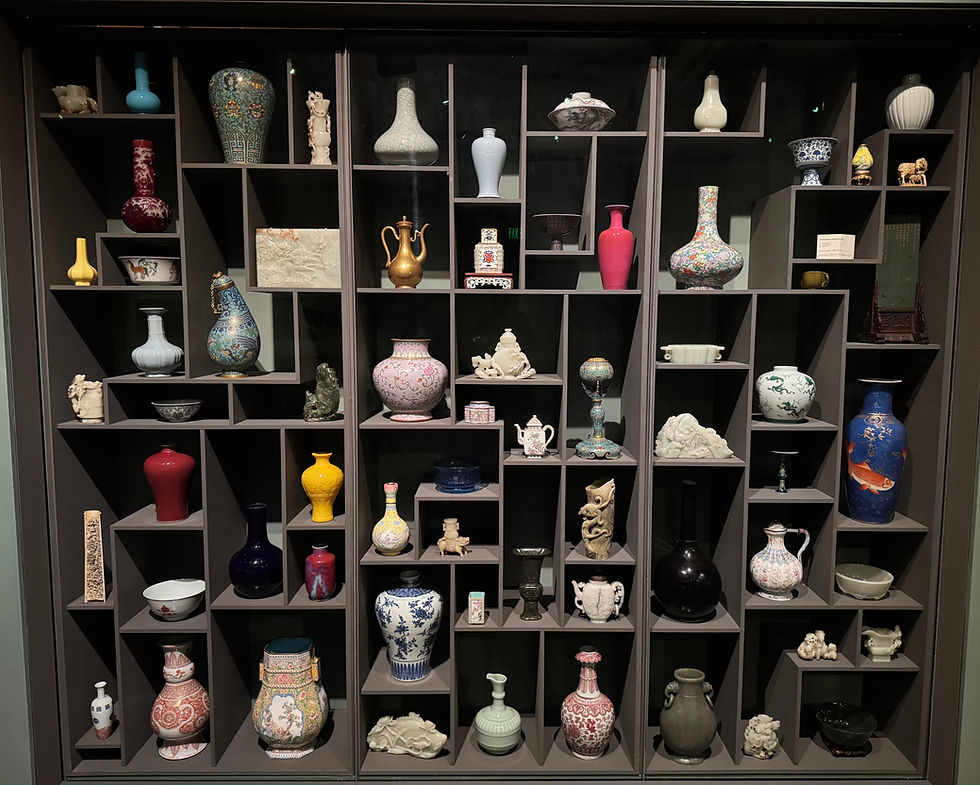'Feeling the Zen' with Lui Shou-Kwan's Chinese Paintings
- Anthony Wu

- Jun 10, 2023
- 3 min read
Updated: Feb 23, 2025
I had a wonderful visit to Minneapolis and Chicago back in early May! It was my first time visiting Minneapolis and here I was joined by a few Asian art colleagues where we were granted a private tour by esteemed Chair of Asian art and curator of Chinese art Dr. Liu Yang of the Minneapolis Institute of Art.
Dr. Yang guided us through his blockbuster exhibition 'Eternal Offerings: Chinese Ritual Bronzes'. These were a reimagining of the Pillsbury bronzes, part of the foundations of the museum's permanent Asian art collection, and one the most important collections of Chinese archaic bronzes in North America.
The settings were staged by Oscar-winning artistic director Tim Yip 葉錦添 (Crouching Tiger, Hidden Dragon) to represent different Chinese elements and themes that touch on the earthly and heavenly realms. It was quite breathtaking!

Image 1. Here is one of the incredible settings of the Pillsbury bronzes at the MIA's exhibition. The scene contain an assortment of ancient bronze vessels mostly from the Zhou Dynasty (1046-256 BCE).
They are presented as offerings for ancestors on an 'artificial' platform that appears to be a metal forge built into a mountainside. The blue transparent cloth has a video projection of clouds, thus imitating light coming down from the heavens.

Image 2. Here is another scene from the MIA's exhibition. This one focuses on archaic vessels and sculptures from the late Bronze Age, with a focus on ancient Chinese ancestral worship.
We were in Minneapolis for three nights, and from there I stopped by Chicago to work on some Asian art cataloguing at Hindman Auctions in preparation for their September 2023 auction.
On my last day in Chicago, I was able to visit The Art Institute of Chicago where I 'chanced' upon works by one of my favourite Chinese painters, Lui Shou-Kwan (Lu Shoukun) 呂壽琨 (1919–1975).
I didn't even know they had this exhibition going on! Titled 'Ink Play: Paintings By Lui Shou-Kwan', the exhibition was spread out over numerous galleries in the museum's Asian art galleries and featured over 30 Chinese paintings from the artist's oeuvre. Many of the works were on loan from The Art Museum at The Chinese University of Hong Kong and Alisan Fine Arts, Hong Kong.
Lui was not always as popular an artist as he is today. Currently he is known as one of the predecessors of East Asia's contemporary ink movement, but it really wasn't until the past 20 years that saw some renewed interest in his pieces. Even so, it's mostly his later abstract 'Zen' works that are the most popular of his repertoire.
Working in Hong Kong's maritime industry, Lui's early works saw him sketch and paint scenes around Hong Kong's mountainous areas, harbours and shorelines. All of these paintings hark back to traditional Chinese ink painting from the past 1000 years.
These traditional landscape scenes are actually some of the works that I am attracted to since it shows the romanticized idea of Hong during my grandparents' time during the 1950's and 1960's. There just isn't the crazy urban development that we envision from the Hong Kong metropolis of today.
Lui's later (and more popular) works were completely different and were highly influenced by Western aesthetics. He was a part time instructor of Chinese painting at The University of Hong Kong and The Chinese University. At these institutions, he was able to research and bring forth new ideas of Western art, such as American abstract expressionism, to his teachings.
These abstract ideas are clearly showcased in his later paintings in the large and bold colour field shapes. Lui also has an interest in the Buddhist and Daoist religions, and from there, he combined the traditional idea of religious ink painting and calligraphy with the modern floating abstract forms. His works were a clear expression of Western and Eastern influences.
Here are some of the earlier and later works I saw at Lui Shou-Kwan's exhibition at the Art Institute of Chicago:

Image 3. 'A Snapshot of Hong Kong' (1967)

Image 4. 'Cape D'SAguilar of Lei Yue Mun' (1968)

Image 5. 'Lion Rock Rainy Day' (1968)

Image 6. (L) 'Zen Painting' (1969) & (R) 'Zen Painting' (1968)

Image 7. (L) 'Zen Painting' (1970) & (R) 'Zen Painting A74-9' (1974)
Thanks for reading this latest blog and hope you enjoyed the images at the MIA and the AIC! And so my Asian art adventures continues throughout the summer. Next up is a big trip to Paris to visit the Arts d' Asie auctions at Bonhams, Christie's and Sotheby's. This will be followed by an Asian art appraisal trip to Vancouver, where I will also be sourcing items for my next October Asian art auction at Heffel Gallery. I'll keep everyone posted!




Comments